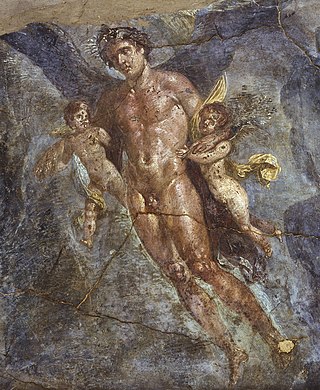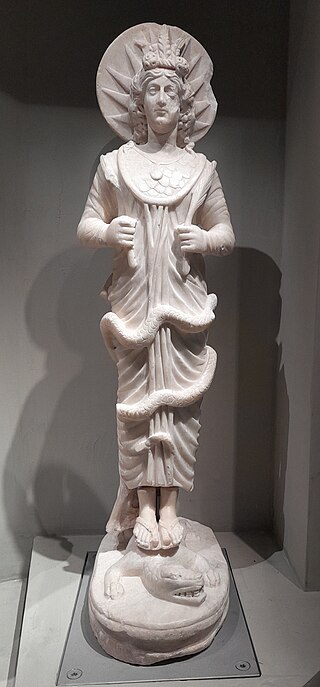Related Research Articles

In Greek mythology and religion, Notus is the god of the south wind and one of the Anemoi (wind-gods), sons of the dawn goddess Eos and the star-god Astraeus. A desiccating wind of heat, Notus was associated with the storms of late summer and early autumn, wetness, mist, and was seen as a rain-bringer. Unlike his two more notable brothers, Boreas and Zephyrus, Notus has little to no unique mythology of his own.

In Greek mythology and religion, Zephyrus, also spelled in English as Zephyr, is the god and personification of the West wind, one of the several wind gods, the Anemoi. The son of Eos, the goddess of the dawn, and Astraeus, Zephyrus is the most gentle and favourable of the winds, and is also associated with flowers, springtime and even procreation. In myths, he is presented as the tender breeze, and he is known for his unrequited love for the Spartan prince Hyacinthus. Although he along with Boreas are the two most prominent wind gods, their role in mythology is relatively limited.

In Greek mythology and religion, Eurus is the god and personification of the east wind, although sometimes he is also said to be southeast specifically. He is one of the four principal wind gods, the Anemoi, alongside Boreas, Zephyrus and Notus. Eurus is featured rarely in ancient literature, appearing together with his three brothers as part of a whole if at all, and virtually has no individual mythology of his own. Often he is excluded entirely, leaving Boreas, Zephyrus and Notus to represent the Anemoi. His Roman equivalent is the god Vulturnus.

Mythology of the Haudenosaunee includes the creation stories and folktales of the Native Americans who formed the confederacy of the Five Nations Iroquois, later the Six Nations Iroquois Confederacy. Historically, these stories were recorded in wampum and recited, only being written down later. In the written versions, the spellings of names differ due to transliteration and spelling variations in European languages that were not yet standardized. Variants of the stories exist, reflecting different localities and times.

Dionysus-Osiris, alternatively Osiris-Dionysus, is a deity arising from the syncretism of the Egyptian god Osiris and the Greek god Dionysus.

Sirocco, scirocco, xlokk, or, rarely, siroc is a Mediterranean wind that comes from the Sahara and can reach hurricane speeds in North Africa and Southern Europe, especially during the summer season.

Twins in mythology are in many cultures around the world. In some cultures they are seen as ominous, and in others they are seen as auspicious. Twins in mythology are often cast as two halves of the same whole, sharing a bond deeper than that of ordinary siblings, or seen as fierce rivals. They can be seen as representations of a dualistic worldview. They can represent another aspect of the self, a doppelgänger, or a shadow.

Interpretatio graeca, or "interpretation by means of Greek [models]", refers to the tendency of the ancient Greeks to identify foreign deities with their own gods. It is a discourse used to interpret or attempt to understand the mythology and religion of other cultures; a comparative methodology using ancient Greek religious concepts and practices, deities, and myths, equivalencies, and shared characteristics.

In ancient Greek religion and myth, the Anemoi were wind gods who were each ascribed a cardinal direction from which their respective winds came, and were each associated with various seasons and weather conditions. They were the progeny of the goddess of the dawn Eos and her husband, the god of the dusk, Astraeus.

A north wind originates in the north and blows in a southward direction. The wind has had historical and literary significance, since it often signals cold weather and seasonal change in the Northern hemisphere.

A west wind is a wind that originates in the west and blows in an eastward direction.
An east wind is a wind that originates in the east and blows in a westward direction. This wind is referenced as symbolism in culture, mythology, poetry, and literature.

Geb, also known as Ceb, was the Egyptian god of the Earth and a mythological member of the Ennead of Heliopolis. He could also be considered a father of snakes. It was believed in ancient Egypt that Geb's laughter created earthquakes and that he allowed crops to grow.
The Situations and Names of Winds is a spurious fragment traditionally attributed to Aristotle. The brief text lists winds blowing from twelve different directions and their alternative names used in different places. According to the manuscript version of the work, The Situations and Names of Winds is an extract from a larger work entitled On Signs likely written by a pseudo-Aristotle of the peripatetic school. Situations is notable as an ancient text which reproduces the concepts of the Anemoi or "wind gods" and classical compass winds, both of which have been historical components of western culture.

In the ancient Mediterranean world, the classical compass winds were names for the points of geographic direction and orientation, in association with the winds as conceived of by the ancient Greeks and Romans. Ancient wind roses typically had twelve winds and thus twelve points of orientation, sometimes reduced to eight or increased to twenty-four.
In Aztec mythology Huitztlampaehecatl is the god of the South wind. His brothers are Cihuatecayotl, Tlalocayotl, and Mictlanpachecatl, who personify the winds from the west, east, and north respectively.

There are a number of deities and personifications associated with seasons in various mythologies, traditions, and fiction.
References
- ↑ Skilling, Tom (18 April 2016). "Ask Tom: Could you explain wind direction terms?". chicagotribune.com. Retrieved 2019-05-30.
- ↑ Luke Roman; Monica Roman (2010). Encyclopedia of Greek and Roman Mythology. Infobase Publishing. pp. 66–. ISBN 978-1-4381-2639-5.
- ↑ Budge, Ernest Alfred Wallis (1904). The Gods of the Egyptians: Or, Studies in Egyptian Mythology. Vol. 2. Methuen & Company. p. 296.
Miscellaneous Gods 2. The South Wind was called Shehbui, or...
- ↑ Harriet Maxwell Converse; Arthur Caswell Parker (1908). Myths and Legends of the New York State Iroquois. University of the State of New York. pp. 37–.
- ↑ de Marliave, Olivier (1995). Pequeño diccionario de mitología vasca y pirenaica. Palma de Mallorca Olañeta D.L. ISBN 9788476512326.